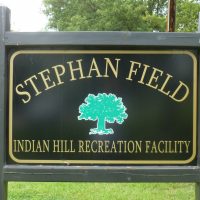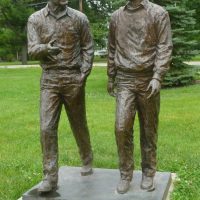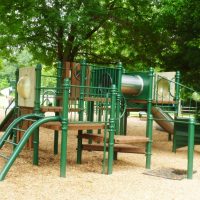Forty years ago, Stephan Field at the southeastern corner of Drake and Shawnee Run was a simple baseball diamond, with two lakes out back. It is named for Paul Stephan, whose enthusiastic promotion of knothole baseball earned praise and whose leadership inspired hundreds of boys in the 1950’s and 1960s.
Paul and Alice Stephan hailed from farms in Brown County, Ohio. As newlyweds, they lived in Clifton; with Alice working on her degree from the University of Cincinnati, and Paul in the government office at the stockyards. He was the first local broadcaster of agricultural news, quoting noon market prices of livestock on WLW radio. After leaving the Cincinnati stockyards, he became a superintendent at Schroth Packing Co. As their family grew, the Stephans wanted to return to farm life. While looking for a farm to buy, Paul was offered a position as manager of a Graves Road estate, a job he held from 1950 until 1963. After this he was manager of a Shawnee Run Road estate, and their sons attended Indian Hill schools.
In 1953, second son Paul, Jr. asked his father to manage his baseball team. Paul agreed, and thus started his long-time commitment to baseball in Indian Hill. Though he had never played, he was familiar with the game and a loyal Reds fan. Learning by doing, Stephan was coach/manager for two of his sons, and then manager/promoter of many other teams for over 20 years. Paul loved his teams, spending up to six hours a night on baseball. The 1950’s knothole teams practiced wherever they could get a field: Drake Elementary, the Village diamond, and Cincinnati Country Day School. He did every job imaginable: lining and dragging the fields, carpooling, scheduling, and finding umpires, sponsors, uniforms, and equipment. Alice helped with storing and mending uniforms. Urging his players to practice every day, he taught them to love the game. Paul, Jr., later batting practice pitcher for the Cleveland Indians for 15 years, threw hundreds of baseballs each night into a basket on a barn wall.
The teams grew from one in 1953 to three in 1955. Stephan tried to find a team for every boy and said baseball was special because “small boys can compete on an equal basis with larger boys”. Early team names were Rangers, Chiefs, Braves, Juniors, Regulars, and Pee Wees. Later names were changed to such colorful titles as Maulers, Tomahawks, Apaches, and Cherokees. By 1962 there were 12 teams, and many Indian Hill boys learned competition and sportsmanship from Paul Stephan. Some championship teams won District Titles, bringing home trophies to be displayed in the Village Hall.
In recognition of Paul’s volunteer labor, Stephan Field was dedicated and named for Paul Stephan in August, 1964. The ceremony included speeches by the Mayor and Council members. Coaches and players from past years came to see the awarding of the bronze plaque which stands there still. Three Cincinnati Reds players delivered a letter of commendation, and later Stephan was inducted into the Cincinnati Knothole Hall of Fame.
Today, Stephan Field is used for baseball, soccer, picnics, walking, jogging, tennis, bocce, and dog walking. To celebrate Philip O. Geier’s 90th birthday, his family commissioned and donated a bronze sculpture of him walking with a friend. Mr. Geier and another long time Village resident, Leslie Applegate, strolled the one mile trail around the perimeter of Stephan Field on a daily basis for years. The Field also has state-of-the-art playground equipment. Nearby the Bicentennial Sculpture stands as a stone storybook of the history of the Village. The three panels depict the major eras and significant organizations in Indian Hill over 200 years. The artistic monuments, erected in 1995, are encircled by a surface whose pavers recognize patron residents.
The dreams of Paul Stephan are fulfilled each warm evening, as village residents come to share Stephan Field–a village treasure, a delight to all. It honors a man who taught the lessons and the love of baseball to many youths in Indian Hill.




